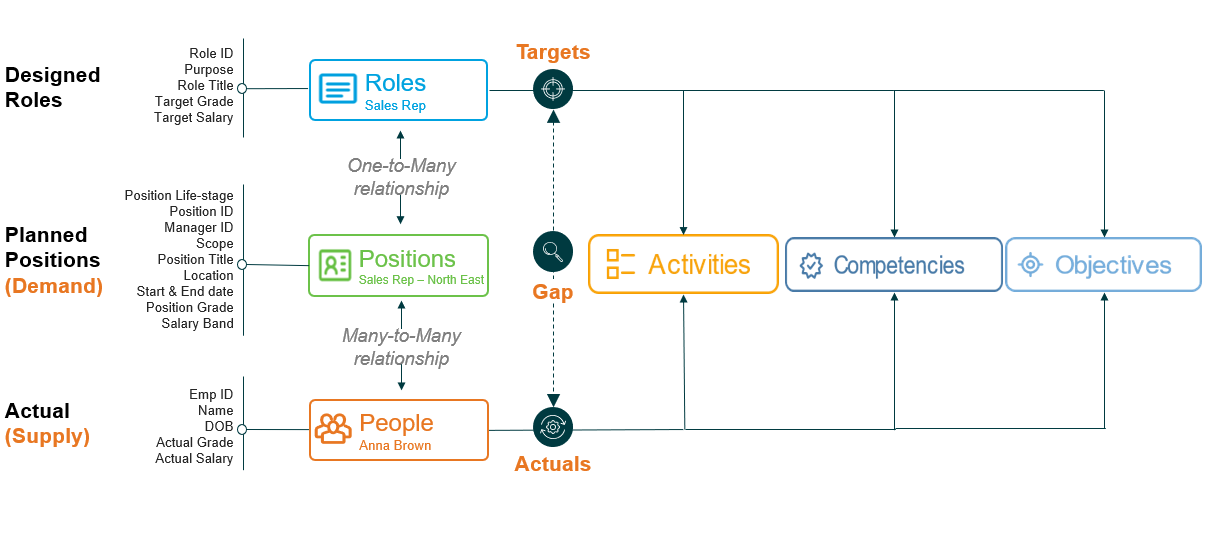Designing organizations around work and value
Discover why shifting focus from people as individuals to the value they create is how organizations can achieve outstanding results.
Published by Orgvue
Home > Resources > article > Designing organizations around work and value
One of the big mistakes that businesses often make with organizational structure is to design around people rather than positions. But this approach is easily tainted by bias and politics and can lead to the business veering off course. Organizational planning isn’t just about the workforce, it’s about understanding the work and activities needed to achieve business objectives and everything related to that.
“People can be champions but organizations win championships”
This well-known statement by celebrated HR expert and commentator, Dave UIrich, sums up the importance of focusing on work and value creation. Ulrich also said, “It’s not talent or people that provide the competitive edge, but organization systems. The key question is how to build an organization as a system to win in the marketplace.”
HR is often distracted by the ‘war for talent’, competing to attract the most skilled or experienced workers as a formula for success. Yet history shows you can have the best people and still fail. What’s more, if you don’t get your organizational design right, you’ll almost certainly fail in the long run.
Why value creation beats talent and skills
To illustrate why focusing on value creation and organizational systems makes such a difference, let’s look at an example from the world of sport. In the 2019 rugby world cup, Japan was grouped with Ireland, one of the best international teams in recent years with an enviable record. Ireland was ranked number one at the time and had some of the best players in the game.
Japan, on the other hand, had never previously qualified for the world cup and they’d only won a few international games in their history. None of the Japanese players would make any of the top national teams. They’re smaller, they’re not as fast, and they’re not as strong.
On 28 September, Japan beat Ireland. Not only that, they won every game and finished top of the group. Clearly, they didn’t win because they have the best players. They won because of their organizational system, their communication, and how they played as a team.
A conceptual understanding of the organizational system
Proving the effectiveness of organizational systems is greater than their component parts, that is people and skills, isn’t difficult. What’s challenging is to understand exactly why this is. And to do that, you need to be able to visually represent those systems using data and analytics. We use a conceptual model to describe the relationship between people and work, so we can see how different activities combine to drive forward business performance. The model also enables us to easily adjust and update the nature and flow of work in response to changing circumstances.

In the context of this article, it may seem paradoxical that we start with people data. But as we’ll see, having a focus on work over individuals doesn’t mean we undervalue the inherent qualities and contribution each person makes.
From ‘people and cost’ to ‘work and value’
We begin to define the work by associating individuals with positions, which are grouped by role. For example, you may have several sales managers (role) for different regions (positions). This relationship helps to quantify the workforce demand of the business over time, which can be compared with the supply that the current workforce represents.

To better understand how to meet future demand, we break down roles into the processes and activities – in other words, the work – alongside the skills and competencies needed to do that work. We then attach accountability metrics to each role, so we can compare how well the work is being done against targets set by the business.
This puts us in a position to regulate productivity by ensuring work isn’t duplicated unnecessarily, trimming back work where too much effort is being spent on particular activities, and redirecting effort elsewhere where it’s needed. Importantly, it also means we can track the financial impact of any changes we make.
This is far more insightful that tracking salary costs across the workforce, which doesn’t tell you the financial contribution the workforce makes, only how much it’s costing you. By shifting focus to the work, you can quantify the value your workforce delivers.
Automation and the changing nature of work
Understanding the value-adding activities your organization carries out, the work that needs to be done to achieve your business objectives, and the additional skills and competencies you need to get there, changes every aspect of organizational planning.
For example, thinking about the work you need to stop doing, rather than the number of people you need to lay off, fundamentally changes the nature of cost reduction programs. Instead of making cuts to the most expensive departments or taking out layers based on cost, organizations could instead evaluate which activities add the least value and which could be reduced, consolidated, transferred, or outsourced.
This focus on activities rather than people and skills is particularly relevant in the context of automation and the changing nature of work. As automation replaces people for routine, repetitive tasks, organizations will need to think how people and machines can carry the business forward together. But it begins with the work, no matter who (or what) does it.
Read next
Read more about organizational planning and analysis (OP&A).
This article outlines the first steps to building an OP&A function for your business.
Read more about organizational planning
Managing a constantly changing business environment demands new analytical skills within organizations to respond to that change and become future-ready. This new way of working is embodied in a forward-looking discipline we call ‘organizational planning and analysis’ (OP&A). Read this article to discover the first steps to building an OP&A function for your business.